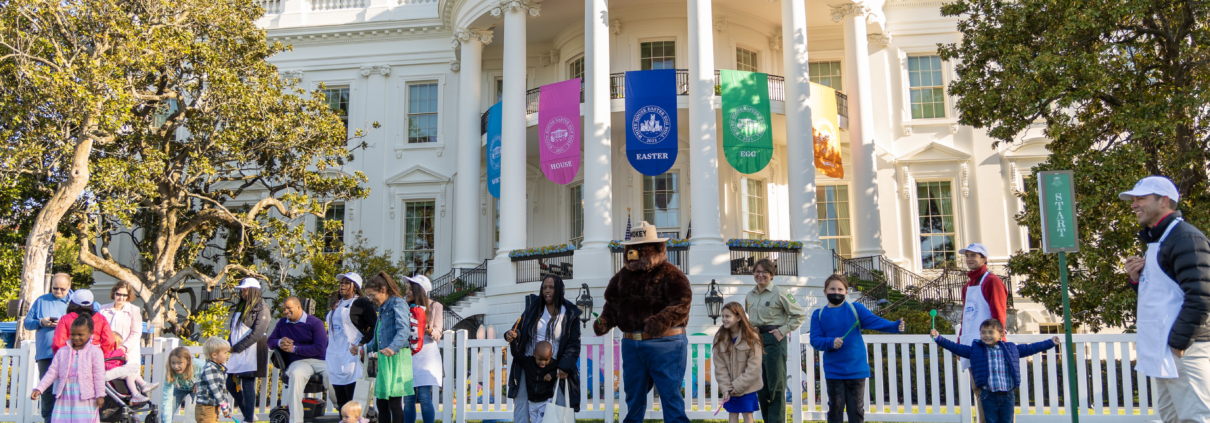The History of the White House Easter Egg Roll
The White House Easter Egg Roll is a tradition that has captivated generations of Americans, blending the Easter spirit with the nation’s most important house. Since 1878, the White House has been home to one of the oldest annual events in its history—the Easter Egg Roll. The festive occasion, held on the South Lawn, brings families together in a spirit of joy and camaraderie.
The White House Easter Egg Roll began in the 19th century, when children would roll eggs down the slopes of Capitol Hill on Easter Monday. This tradition, filled with laughter and excitement, quickly gained popularity, becoming a popular Easter pastime for families in Washington D.C. and beyond. However, as the event grew in popularity, concerns arose about the impact of egg rolling on the grounds of Capitol Hill. The playful activities of children rolling eggs down the hill began to take a toll on the landscape, prompting authorities to take action. In 1876, a ban was placed on egg rolling on Capitol Hill, effectively putting an end to this beloved Easter tradition in that location.
Despite the ban, the spirit of Easter and the joy of egg rolling remained alive in the hearts of children and families. In a moment of inspiration and goodwill, President Rutherford B. Hayes made a historic decision in 1878 that would forever change the course of Easter celebrations in America. Recognizing the importance of preserving traditions and fostering a sense of community, President Hayes opened the South Lawn of the White House to egg rollers.
Throughout history, American presidents and their families have added their own unique touches to the Easter Egg Roll. From egg roll races hosted by the Nixons to wooden egg hunts with signatures of famous people by the Reagans, each administration has left its mark on this iconic event. Over the years, the Egg Roll has been enhanced by memorable attractions and souvenirs. From certificates of participation to plastic eggs with notes from First Ladies, these mementos add to the magic of the day.
The Egg Roll is not just a singular event but a day filled with many Easter related activities that cater to people of all ages and interests. Beyond the traditional egg rolling, attendees can immerse themselves in a world of excitement and fun through a variety of engaging and entertaining activities. One of the highlights is the egg ball game, where participants use specially designed balls resembling eggs to play a unique and lively version of traditional ball games. Another popular activity is the egg toss and catch, where participants form teams and test their coordination and teamwork skills by tossing and catching eggs at varying distances.
In addition to these egg-themed activities, the event offers a range of live entertainment options that cater to diverse tastes and interests. From musical performances and dance showcases to interactive shows and demonstrations, there’s something for everyone to enjoy and be entertained by. Moreover, storytelling sessions add a touch of magic and imagination to the day, transporting participants into enchanting worlds of tales and adventures. Storytellers captivate audiences of all ages with their engaging narratives, fostering a love for storytelling and literature among attendees.
The Egg Roll has weathered challenges, including cancellations during wartime and inclement weather. Yet, it has always bounced back, showcasing the resilience and enduring spirit of the White House and its traditions. In recent years, the Egg Roll faced challenges due to the coronavirus outbreak, leading to cancellations by Presidents Trump and Biden, in 2020 and 2021 respectively.
As we look forward to the 2024 White House Easter Egg Roll, let’s celebrate its rich history, cherished traditions, and the joy it brings to families across the nation. It’s a time to come together to celebrate the United States and the Easter holiday.
Cited Sources:
“Easter Egg Roll: Fanfare and Keepsakes.” WHHA (En-US), 2022, www.whitehousehistory.org/easter-egg-roll-keepsakes. Accessed 22 Mar. 2024.
“Easter Egg Roll: Years without an Easter Monday.” WHHA (En-US), 2020, www.whitehousehistory.org/easter-egg-roll-wartime. Accessed 22 Mar. 2024.
“Easter Egg Roll: Games, Old and New.” WHHA (En-US), 2024, www.whitehousehistory.org/easter-egg-roll-games. Accessed 22 Mar. 2024.
“Origins of the White House Easter Egg Roll.” WHHA (En-US), 2023, www.whitehousehistory.org/origins-of-the-white-house-easter-egg-roll. Accessed 22 Mar. 2024.
Image Source:
“Gallery Item Display (U.S. National Park Service).” Nps.gov, 2024, www.nps.gov/media/photo/gallery-item.htm?pg=2940588&id=0e506461-0bbe-437f-ae05-278532644125&gid=2EE520BE-1DD8-B71C-07A70F451399D44D. Accessed 22 Mar. 2024.



